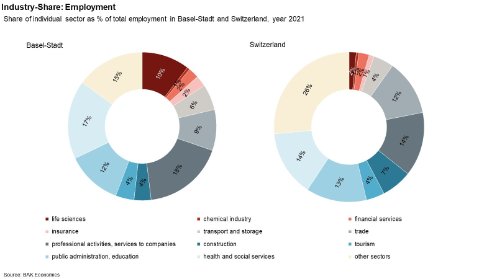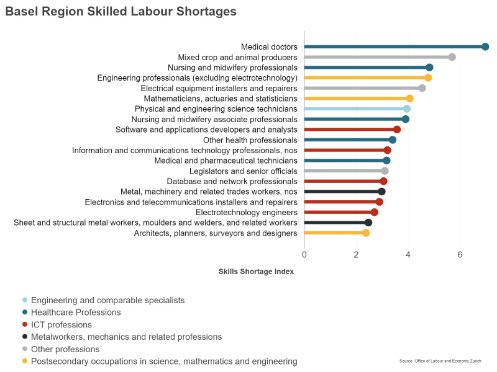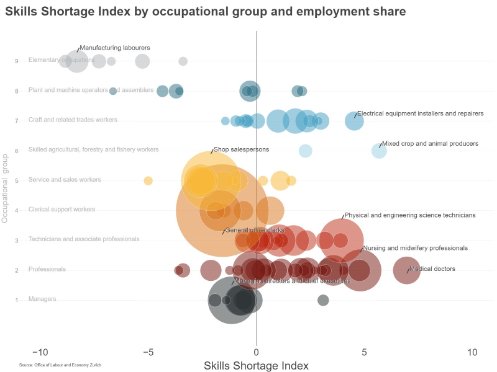Labour market

Employment, unemployment and shortage of skilled workers. Here you can find the most important figures and charts for Basel-Stadt's labour market.
Employment and unemployment
| 2012 | 2017 |
2020 |
2021 | 2022 | |
|---|---|---|---|---|---|
| Employed persons (in thousand) |
184.7 | 190.5 |
188.8 |
193.0 |
- |
| Unemployment rate | 3.7 % | 3.6 % | 3.9 % | 3.9 % | 3.0 % |
| Cross-border commuters (in thousand) |
32.9 | 35.7 | 34.5 | 34.5 | 35.0 |
| Cross-border commuters ratio DE |
46.9 % | 48.2 % | 47.5 % | 47.0 % | 46.4 % |
| Cross-border commuters ratio FR |
52.7 % | 50.8 % | 51.4 % | 51.9 % | 52.5 % |
Source: Federal Statistical Office – STATENT / Cross-border Commuters Statistics; State Secretariat for Economic Affairs – unemployment statistics
Sectoral structure : Employed persons
The following analysis shows figures and graphs on sectoral and industry-specific employment trends in the canton of Basel-Stadt from 1970 and 1998 respectively:
Need for skilled labour in the Basel region
Companies depend on qualified specialists. However, in many sectors it is difficult to find suitable labour. We speak of a skilled labour shortage when the demand for skilled workers exceeds the supply.
The Zurich Office of Economy and Labour (AWA) has compiled a skilled labour shortage index for 2023 in an attempt to measure the need for skilled professionals. The index suggests that in the Basel region there is particularly high demand for people with a scientific training along with technical specialists.
The graphic above shows the 19 occupations with the highest skilled labour shortage index. Doctors top the list. There are different reasons for this:
- There are relatively few doctors in relation to vacancies;
- Doctors usually do not have to search long for a new job in the Basel region;
- Vacancies often cannot be filled for a long time;
- Doctors must be very well trained.
There is also a great need for skilled labour in other health professions. Currently there is particularly high shortage in five professional groups:
(1) Health professionals;
(2) Academic professions in science, mathematics, and engineering;
(3) Professions in the field of information and communication technologies (ICT);
(4) Engineers and comparable specialists;
(5) Metalworkers, mechanics, and related professions.
Visible differences between professions
In order to find out more about the economic significance of the shortage of skilled labour in individual professions, the index is combined with the employment figures (see graphic below). The size of the circle shows the proportion of employees in an occupation in total employment: The bigger the bubble, the higher the share of employment. This proportion is compared with the skilled labour shortage index. The further to the right the circle is, the greater the need for skilled labour in this profession. Doctors, qualified nurses, and engineering professions are widespread professions with many jobs available and a high need for skilled labour. General office works and salespersons are also common professions, but the skilled labour shortage in these occupations is less severe.
Additional information: The index compares various labour market indicators to determine the relative need for skilled labour in a particular occupational field. Specifically, the indicator consists of the following four sub-indicators: (1) Ratio of vacancies to job seekers, (2) duration of the job advertisement, (3) duration of the job search (vacancy period) and (4) qualification requirements. The Basel region described in this evaluation includes the cantons of Basel-Stadt, Basel-Landschaft, and Solothurn. Occupations are defined on the basis of the Swiss Standard Classification of Occupations CH-ISCO-19 and are considered at the level of occupational subgroups (CH-ISCO-19 3-digit code, referred to as “occupations”; “main occupational groups” are in turn referred to at the level of CH-ISCO-19 1-digit code).



